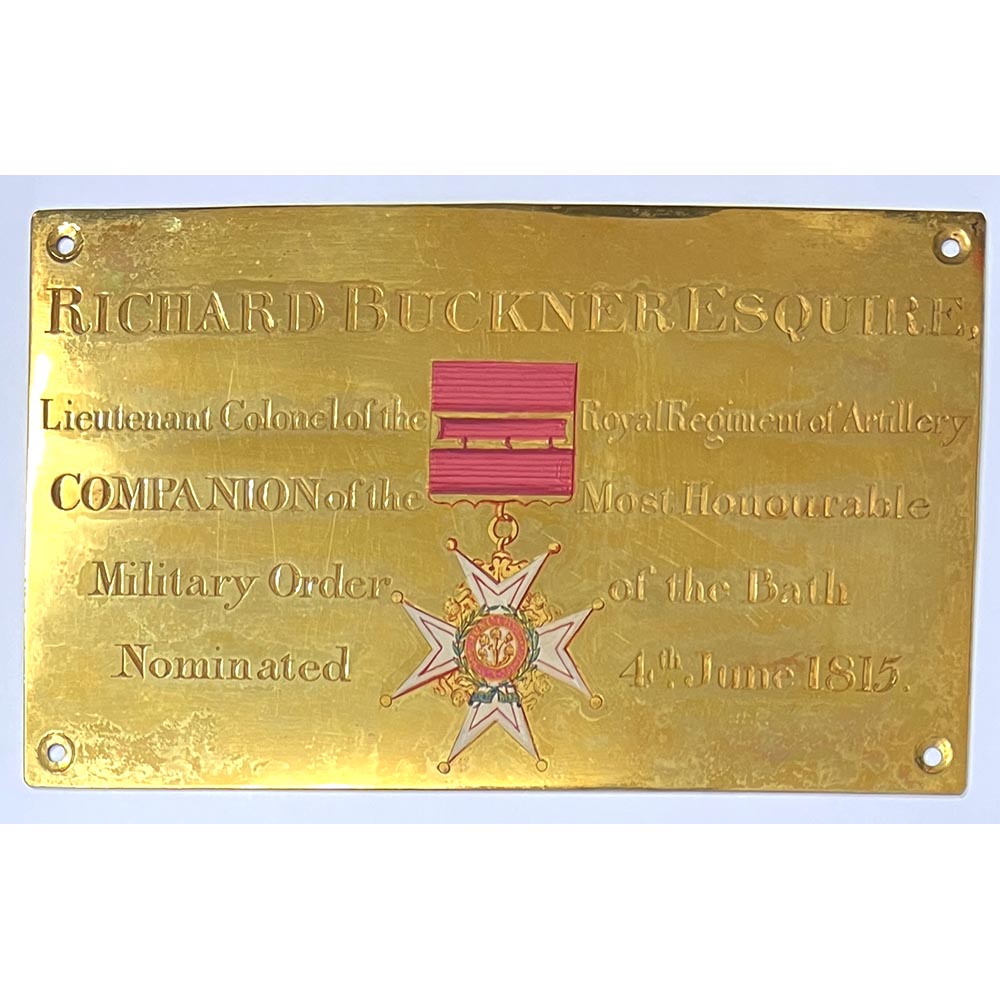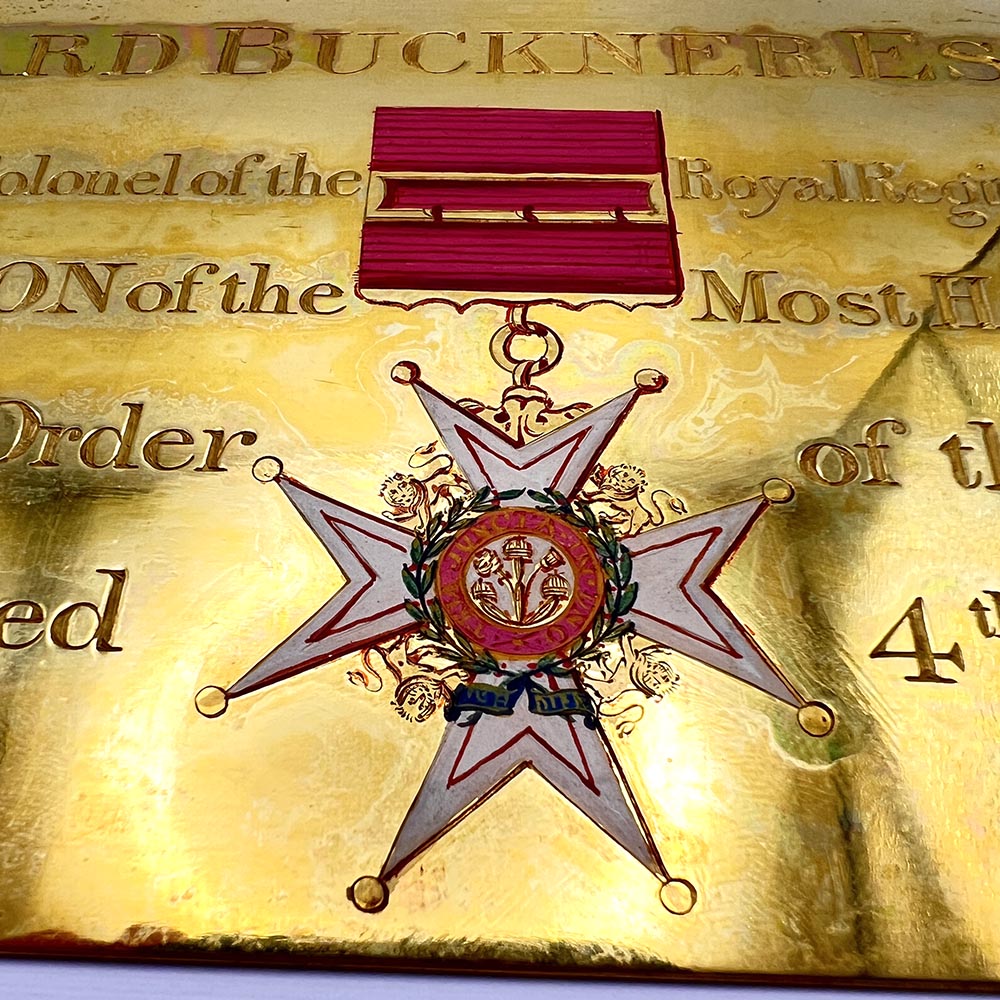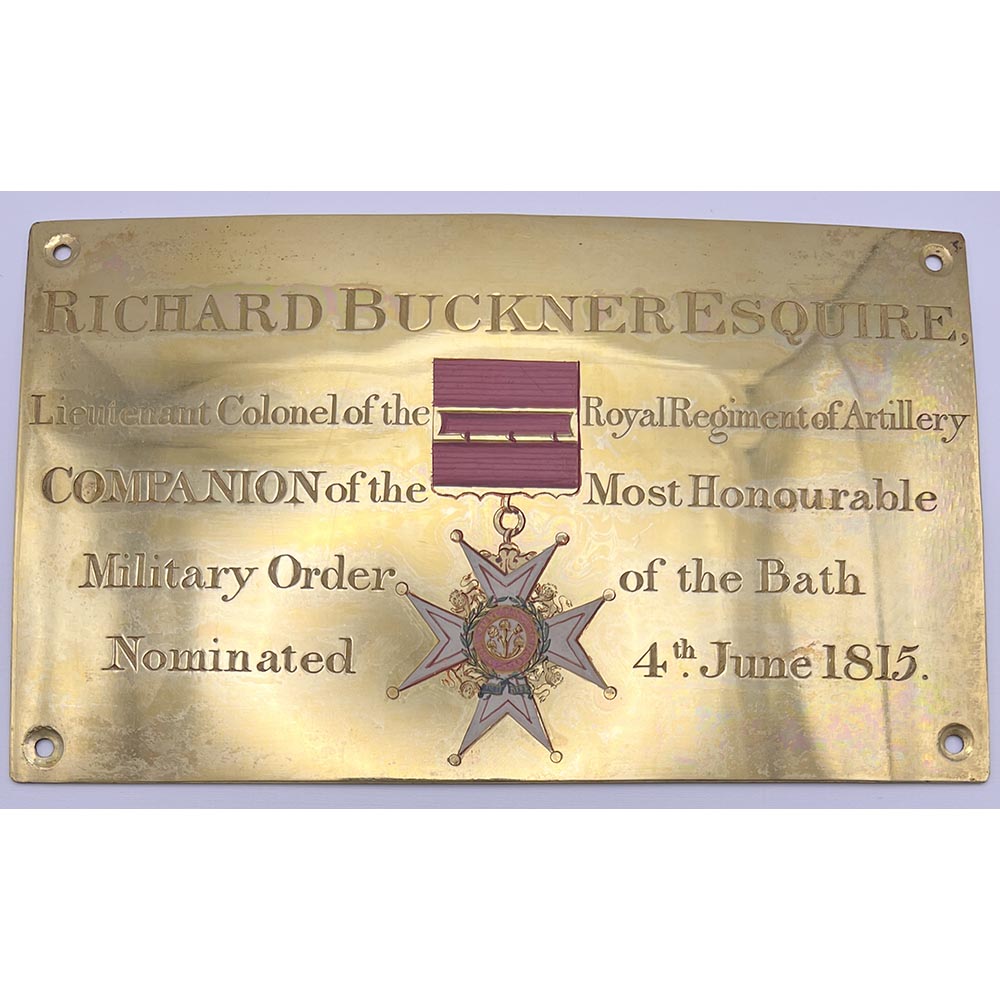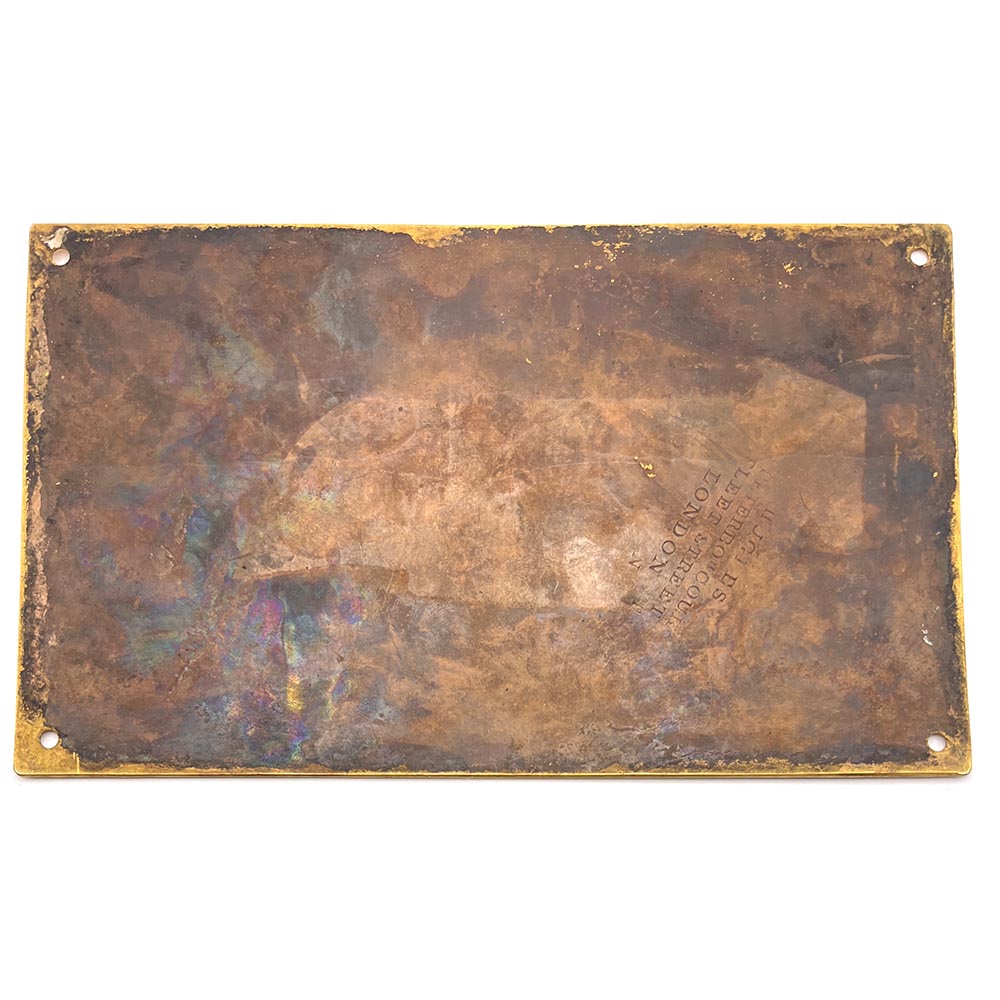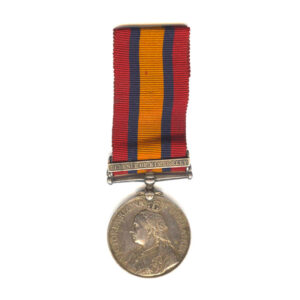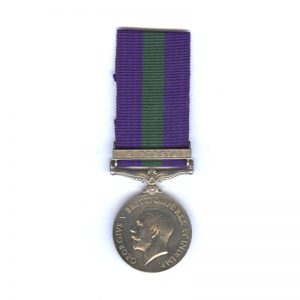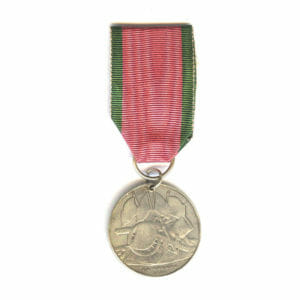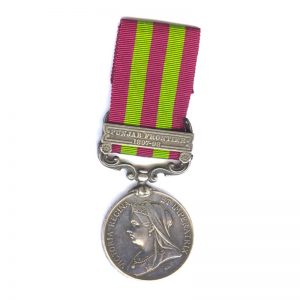Description
Order of the Bath Stall Plate, Lt Colonel Richard Buckner, Royal Artillery, recipient of the Army Gold Medal for Vittoria and bars for both St Sebastian Siege and Nivelle.
He gained 3 battle honours during the Peninsular Wars, being decorated with the Field Officer’s Gold Medal for all 3.
An Order of the Bath C.B. Stall Plate, with makers markings on the reverse of “Hughes, Peterborough Court, Fleet Street, London” Hughes were a well regarded plate maker and engraver in London during the period.
The front-side has a finely painted depiction of the Military C.B. Breast Badge in gold.
It has been engraved to “RICHARD BUCKNER ESQUIRE, Lieutenant Colonel of the Royal Regiment of Artillery
COMPANION of the Most Honourable Military order of the Bath
Nominated 4th June 1815.”
Lieutenant Colonel Richard Buckner, Royal Artillery, was a particularly exceptional Soldier who fought in the Peninsular Wars.
Coming from a good family, his father was the admired Admiral Charles Buckner, one time “Admiral of the Red” the 2nd highest posting in the entirety of the Royal Navy. A very respected Naval Officer who during his seagoing years fought in the American War of Independence, Revolutionary Wars, where he as Captain captured the American Privateers Scourge and Rhodes during 1782.
He would also be the Commander in Chief on the Nore during the infamous Spithead and Nore Mutinies, which led to the “Earl St Vincent” medal being created for those who remained loyal.
His uncle was the Bishop of Chichester, John Buckner.
His son and namesake, Richard Buckner (1812-1893), also did his Army Service as a young man, whilst stationed in Rome, he studied painting under the Neoclassical Artist Giovanni Battista Cassevari.
Any London visitors might wish to see his famous paintings which are held in the collections of the National Portrait Gallery in London, perhaps his finest Oil Painting, “Portrait of a Boy” is in the Victoria and Albert Museum.
As he was such a well recommended Portrait Painter amongst high society, 8 National Trust properties display his paintings.
There are also works by Buckner at the British Museum, the National Army Museum, Windsor Castle, Osborne House, Woburn Abbey, the Birmingham Art Gallery, Harewood House, the Foundling Hospital, County Hall, Maidstone and Castle Leslie in Ireland. Queen Adelaide, Queen Victoria and Prince Albert commissioned some of his paintings.
His eldest son, named after his distinguished Grandfather, was Reverend Charles Buckner (1807-1871), Rector of West Stoke, Sussex and inherited the family home of Wyke House.
LIEUTENANT COLONEL RICHARD BUCKNER 1772-1837, OF WHYKE HOUSE, CHICHESTER, ARMY GOLD MEDAL AND 2 CLASPS, ROYAL REGIMENT OF ARTILLERY, DEPUTY LIEUTENANT OF SUSSEX
EARLY LIFE
Richard was born in 1772, to Admiral, at the time Captain Charles Buckner, Royal Navy, who had been on a short break from commanding ships at sea having recently returned home from Barbados.
Fortunately for his childhood his father remained at Home for the 1770s, before taking up a commission on the French Prize “Prothee”, setting off when Richard was about 9 years old.
JOINING THE ARMY
On 24th April 1793, Richard was commissioned into the Royal Artillery, next year he was promoted to Lieutenant on 1st January 1794.
Followed by Captain Lieutenant on 2nd November 1897.
Promoted to Captain on 9th September 1802.
That year he married Mary Marsh (nee Pierce) at St James in Westminster, London, on 15th November 1802.
He first saw active service as a Captain of Artillery during the Helder Expedition of 1799, with the Anglo Russian invasion of Holland, fighting against the French and Batavian Republic.
Before going to France he was deployed in the Mediterranean during 1806, 1807 and 1808, and had been stationed in Sicily during 1806 in command of the 6th Company of the 8th Artillery.
During this time his junior officer was 2nd Captain Charles Cornwallis Dansey, whose letters were published detailing his time under Buckner in the Mediterranean, by Gareth Glover.
Click here for the Letters of 2nd Captain Charles Dansey, under Capt Buckner during 1806-1808
Young Captain Dansey certainly had a lovely time in the region, taking some time to climb Mount Etna and visit all the classic Ancient Greek sites in the area.
And also took part in the ill-fated Walcheren Expedition.
He was then promoted to Brevet Major on 25th July 1810 and Major on 27th September 1810.
THE PENINSULAR WAR WITH THE DUKE OF WELLINGTON
During the Peninsular Wars against France he was deployed as a Major in command of his own troop.
During the wars he showed further promise and was promoted to Brevet of Lieutenant Colonel on 22nd November 1813, shortly after he earned his first Field Officer Gold Medal in command of the Left Centre Column Artillery Brigade at the Battle of Vittoria.
BATTLE OF VITTORIA, 21st June 1813, EARNING THE FIELD OFFICER’S GOLD MEDAL AND PROMOTION TO LT COLONEL
At the time he was a Major, he served in the Left Centre Column, under Lt General George Ramsay, 9th Earl of Dalhousie.
With him was 15000 infantry, the 3rd Division of Infantry under Lt Gen Thomas Picton & the 7th Division under Lt Gen the Earl of Dalhousie.
Major Richard Buckner was in command of the entire section’s Artillery, with control of both Cairne’s Company (attached to the 7th Division) and Douglas Company (attached to the 3rd).
BATTLE OF NIVELLE, 10th NOVEMBER 1813, GOLD MEDAL NUMBER 3
“Lt Colonel Frazer and Buckner opened a vigorous fire on the first redoubt… the effect of the fire was such as to compel the enemy to abandon the redoubt without waiting for the assault.”
The Artillery with Sir John Hope’s column was but little engaged, as its advance depended on the success of the right; but it kept up a heavy and successful cannonade, and met with a few casualties. The Artillery on the right, in support of the attack on the redoubts, was, however, of essential service; and was skilfully handled by the Field Officers in charge, Lieut.-Colonels Frazer and Buckner. They opened a vigourous fire on the first redoubt, while the 4th Division was moving forward to assault it, and the effect of the fire was such as to compel the enemy to abandon the redoubt without waiting for the assault. At this time the Chestnut Troop distinguished itself especially. “I must particularly notice,” wrote Colonel Dickson, “the gallant manner in which Lieut.-Colonel Ross’s troop was moved to an advanced position, when it reopened its fire at the distance of 350 yards from the work, and covered the approach of the others. In this operation Lieutenant Day was severely wounded.” As soon as the enemy quitted the first redoubt, the guns moved forward to support the 7th Division in the attack of the second, but after a few rounds it also was abandoned.
PROMOTION
Promoted to full Lieutenant Colonel on 20th December 1814.
With the revamp of the Order of the Bath in Early 1815, the order was opened up to Officers who had received a medal or mention in despatches in the recent wars since 1803.
Naturally Buckner was on the list of about 500 men presented having earned 3 “Gold Medals”, he was invested as a Companion in the Military Division of the Most Honourable Order of the Bath on 4th June 1815.
Continuing his Army Service he later retired with the rank of Lieutenant Colonel on 12th June 1823.
He retired to Wyke House in Rumboldswyke. During his retirement he was made Deputy Lieutenant of Sussex.
He later died there on 13th March 1837, and was buried in Chichester Cathedral.
